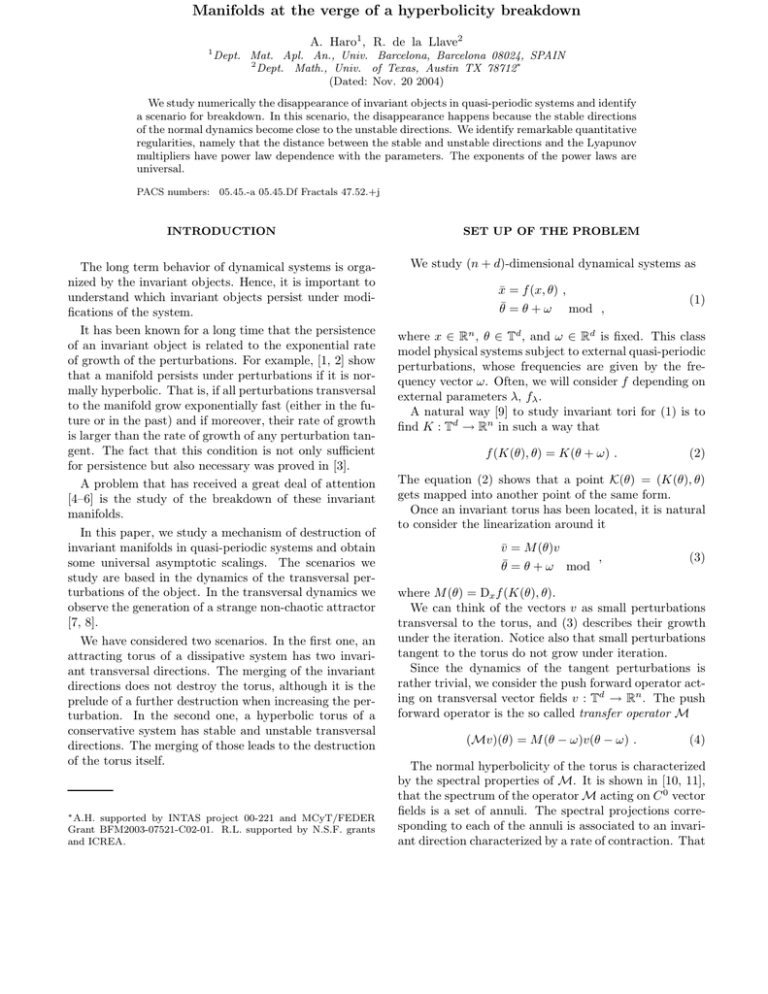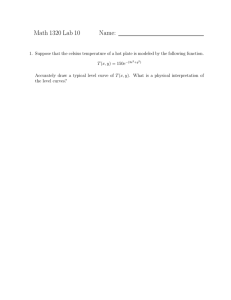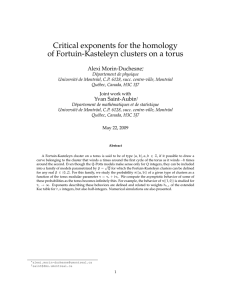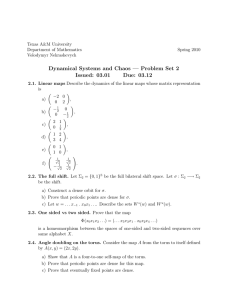Manifolds at the verge of a hyperbolicity breakdown A. Haro
advertisement

Manifolds at the verge of a hyperbolicity breakdown A. Haro1 , R. de la Llave2 1 Dept. Mat. Apl. An., Univ. Barcelona, Barcelona 08024, SPAIN 2 Dept. Math., Univ. of Texas, Austin TX 78712∗ (Dated: Nov. 20 2004) We study numerically the disappearance of invariant objects in quasi-periodic systems and identify a scenario for breakdown. In this scenario, the disappearance happens because the stable directions of the normal dynamics become close to the unstable directions. We identify remarkable quantitative regularities, namely that the distance between the stable and unstable directions and the Lyapunov multipliers have power law dependence with the parameters. The exponents of the power laws are universal. PACS numbers: 05.45.-a 05.45.Df Fractals 47.52.+j INTRODUCTION SET UP OF THE PROBLEM The long term behavior of dynamical systems is organized by the invariant objects. Hence, it is important to understand which invariant objects persist under modifications of the system. It has been known for a long time that the persistence of an invariant object is related to the exponential rate of growth of the perturbations. For example, [1, 2] show that a manifold persists under perturbations if it is normally hyperbolic. That is, if all perturbations transversal to the manifold grow exponentially fast (either in the future or in the past) and if moreover, their rate of growth is larger than the rate of growth of any perturbation tangent. The fact that this condition is not only sufficient for persistence but also necessary was proved in [3]. A problem that has received a great deal of attention [4–6] is the study of the breakdown of these invariant manifolds. In this paper, we study a mechanism of destruction of invariant manifolds in quasi-periodic systems and obtain some universal asymptotic scalings. The scenarios we study are based in the dynamics of the transversal perturbations of the object. In the transversal dynamics we observe the generation of a strange non-chaotic attractor [7, 8]. We have considered two scenarios. In the first one, an attracting torus of a dissipative system has two invariant transversal directions. The merging of the invariant directions does not destroy the torus, although it is the prelude of a further destruction when increasing the perturbation. In the second one, a hyperbolic torus of a conservative system has stable and unstable transversal directions. The merging of those leads to the destruction of the torus itself. We study (n + d)-dimensional dynamical systems as ∗ A.H. supported by INTAS project 00-221 and MCyT/FEDER Grant BFM2003-07521-C02-01. R.L. supported by N.S.F. grants and ICREA. x̄ = f (x, θ) , θ̄ = θ + ω mod , (1) where x ∈ Rn , θ ∈ Td , and ω ∈ Rd is fixed. This class model physical systems subject to external quasi-periodic perturbations, whose frequencies are given by the frequency vector ω. Often, we will consider f depending on external parameters λ, fλ . A natural way [9] to study invariant tori for (1) is to find K : Td → Rn in such a way that f (K(θ), θ) = K(θ + ω) . (2) The equation (2) shows that a point K(θ) = (K(θ), θ) gets mapped into another point of the same form. Once an invariant torus has been located, it is natural to consider the linearization around it v̄ = M (θ)v θ̄ = θ + ω mod , (3) where M (θ) = Dx f (K(θ), θ). We can think of the vectors v as small perturbations transversal to the torus, and (3) describes their growth under the iteration. Notice also that small perturbations tangent to the torus do not grow under iteration. Since the dynamics of the tangent perturbations is rather trivial, we consider the push forward operator acting on transversal vector fields v : Td → Rn . The push forward operator is the so called transfer operator M (Mv)(θ) = M (θ − ω)v(θ − ω) . (4) The normal hyperbolicity of the torus is characterized by the spectral properties of M. It is shown in [10, 11], that the spectrum of the operator M acting on C 0 vector fields is a set of annuli. The spectral projections corresponding to each of the annuli is associated to an invariant direction characterized by a rate of contraction. That is, a gap of the spectrum in the circle of radius ρ produces an invariant splitting Rn = Eθ+ ⊕ Eθ− characterized by ( v ∈ Eθ+ ⇔ |Mm [v](θ)| ≤ Cλm +v m ≥ 0 (5) v ∈ Eθ− ⇔ |Mm [v](θ)| ≤ Cλm −v m ≤ 0 where C > 0, 0 < λ+ < ρ < λ− . For instance, if ρ = 1 the torus is normally hyperbolic and E ± are the stable and unstable subbundles. If the spectral radius is smaller than one, and ρ < 1 separate the spectrum, then E ± are the fast and slow stable bundles of an attracting torus. It is shown in [12] that in the case that the splittings are one-dimensional, there are much more effective algorithms. We will refer to this case as reducible. An invariant manifold is persistent under perturbations if and only if the spectrum of M does not contain the unit circle or, equivalently, if at every point we can find splittings as in (5) with λ+ < 1 < λ− [3, 10]. Hence, the study of disappearance of invariant manifolds is related to the study of mechanisms that lead to the disappearance of splittings satisfying (5). There are several such mechanisms described in the mathematical or numerical literature. For example, the Lyapunov multipliers may go to one, or there may be a saddle node bifurcation for the torus [13]. The goal of this paper is to propose a new mechanism. This mechanisms is based in the fact that the splitting becomes zero in a complicated set. We will find, nevertheless, remarkable quantitative regularities. One amusing consequence of this scenario is that the spectrum of the operator Mλ is discontinuous at λ = λc . In the models we have considered, with n = 2, the spectrum before the collision is two circles whose radius are the Lyapunov multipliers, and in the collision the spectrum is the full annulus enclosed by the circles. The effect of bundle collapses on the invariant manifolds depends very strongly on whether the Lyapunov multipliers straddle 1 or not. When the Lyapunov multipliers straddle 1, the manifold ceases to be normally hyperbolic and, according to the theory, one expects that the manifold does not persist under perturbations. When the Lyapunov multipliers of the bundles do not straddle 1, the manifold loses reducibility – hence, computing it becomes harder and the behavior of orbits near it changes – but does not lose normal hyperbolicity and still persists. Notice that for saddle-node bifurcations, β = 0.5,B = 0.5, Λc = 1, and that, moreover, the bundles remain smooth. NUMERICAL EVIDENCE Bundle merging causing loss of reducibility for an attracting torus Our first study is on the rotating Hénon map, a quasiperiodic dissipative map given by x̄ = 1 + y − b x2 + λ cos(2πθ) THE BUNDLE MERGING SCENARIO FOR DESTRUCTION OF INVARIANT MANIFOLDS We consider a system (1) depending on a parameter λ. The algorithms in [12] allow to continue with respect to λ the manifolds which are close to breakdown. Hence, it is possible to identify a plausible scenario for breakdown of hyperbolicity. In this situation, the invariant splittings become less regular (in the transition point, they become fractal), but there are several quantitative predictions. We will be considering two invariant bundles which start to become less regular in a critical value λc . We claim that for all systems in a small neighborhood. Assertion 1. The distance ∆ between the two invariant bundles near the critical value λc satisfies ∆(λ) ≈ α|λc − λ|β , (6) where λc is the critical point and α, β are parameters. Moreover, β ' 1. Assertion 2. The maximal Lyapunov multiplier Λ of the cocycle near the critical value λc behaves as Λ(λ) ≈ Λc + A|λc − λ|B , (7) where A,B (and λc ,Λc ) are parameters. Moreover, B ' 0.5. ȳ = cx θ̄ = θ + ω (8) mod where b and c are the parameters of the Hénon map and λ is the strength of the quasi-periodic forcing. The variable θ is the phase of the external system rotating with √ frequency ω. We have taken ω = 21 ( 5 − 1). In the following, the parameters are b = 0.68 and c = 0.1. For λ = 0, the curve (a 1D torus) p c − 1 + (c − 1)2 + 4b θ → (x+ = , y = cx+ , θ) 2b is normally hyperbolic with one stable direction and one unstable. There is also an attracting periodic curve, of period 2. We have continued with respect to λ the invariant torus, and computed the distance ∆ between the invariant bundles of the linearized dynamics (3) and the maximal Lyapunov exponent Λ. The results are displayed in Figure 1, where we observe several transitions, labelled with the letters a,b,c,d,e. As λ changes, there is a period doubling bifurcation for λ ' 0.254 (label a in Figure 1), and the torus becomes attracting. In this bifurcation, the unstable bundle becomes a slow stable bundle (the corresponding Lyapunov multiplier crosses the value 1). λ = 0.463254 π λ= 0.463254 1.13 1.1 1.125 3π/4 1 1.12 0.9 α π/2 α 1.115 0.8 Λ 1.11 0.7 π/4 1.105 0.6 0 0.5 a ∆ 0.4 0.3 0.2 0.1 0 0 b cd 0 0.1 0.2 0.3 0.4 0.5 θ 0.6 0.7 0.8 0.9 1 1.1 0.587 0.5875 0.588 0.5885 θ 0.589 0.5895 0.59 0.5895 0.59 e ∆ Λ λ = 0.463255 π λ= 0.463255 1.13 1.125 3π/4 1.12 0.1 0.2 0.3 0.4 λ 0.5 0.6 0.7 0.8 0.9 α π/2 α 1.115 1.11 π/4 1.105 FIG. 1: Distance (∆) between the invariant bundles and Lyapunov multiplier (Λ) of an invariant torus, continued with respect to λ. In b of Figure 1, with λ ' 0.463, the slow directions merge with the fast directions causing a loss of reducibility. We have detected that the collapse of the bundles is produced for λc ' 0.4632544711720. The critical value of the Lyapunov multiplier is Λc ' 0.542306556. The torus continues to be attractive. The collapse of the bundles is depicted in Figure 2. Since the transversal direction is a plane, to indicate a one dimensional space, it suffices to select one angle α between 0, π. The figure indicates this angle of the direction as a function of θ. Notice the dramatic difference caused by a change of 10−6 in the parameter λ. The figure suggests that at breakdown the invariant directions become very complicated. Notice the visual similarity with the phenomena mentioned in [14–16]. In order to study the power laws of the assertions, we have computed the values of ∆ and Λ for λ = 0.4632520 to λ = 0.4632544, with a step h = 0.0000001. We fit parameters in (6) and (7) to obtain estimates of α, β, A, B, λc , Λc . See Figure 3. To asses the reliability we have used several different ways of fitting taking into account that some data are more reliable than others. We have found very useful the capabilities of gnuplot. Our conclusions are: β ' 0.999995 ± 5 · 10−7 , B ' 0.500949 ± 3 · 10−5 . The error estimates correspond to the fits. Note that β ' 1 and B ' 0.5. In the transition c, the torus gains again reducibility, that is lost again in d. We have checked the assertions for both transitions. The results are β ' 0.999961 ± 1 · 10−5 , B ' 0.506147 ± 2 · 10−4 0 0 0.1 0.2 0.3 0.4 0.5 θ 0.6 0.7 0.8 0.9 1 1.1 0.587 0.5875 0.588 0.5885 θ 0.589 FIG. 2: Slow directions (red) and fast directions (blue) before and after the transition of lack of reducibility, and magnification of a very small region. The distance between the attractor and the repellor for λ = 0.463254 is ∆ ' 1.86 · 10−6 . 1e-05 0.544 ∆(λ) 8e-06 Λ(λ) 0.5435 6e-06 ∆ Λ 0.543 4e-06 0.5425 2e-06 0 0.463252 0.463253 λ 0.463254 0.463255 0.542 0.463252 0.463253 λ 0.463254 FIG. 3: Fits of ∆ and Λ to the formulas (6) and (7). for the transition c and β ' 0.999984 ± 1 · 10−5 , B ' 0.492370 ± 1 · 10−4 for the transition d. The transition e is quite different. The torus is not reducible before the transition and when the maximal Lyapunov multiplier crosses 1 it ceases to be normally hyperbolic, and the torus is destroyed. The remaining object is a strange attractor. In summary, the formation of a strange non chaotic attractor for the linearized dynamics of an attracting torus is the prelude of the destruction of the torus and the formation of a strange chaotic attractor for the non linear dynamics. We have also studied models like (8), either changing the parameters or replacing the second equation by ȳ = c(1 − e sin(4πθ))x, where e is a small parameter, say e = 0.1. The results give again numerical evidence of the assertions. 0.463255 Bundle merging associated to breakdown We have checked the scaling laws by fitting all the parameters. See Figure 6. The results are Our second study is on the rotating standard map, a quasi-periodic conservative map given by λc ' 0.379696 ± 2 · 10−7 , β ' 0.969009 ± 9 · 10−5 , 1 x̄ = x + y − sin(2πx)(K + λ cos(2πθ)) 2π 1 ȳ = y− sin(2πx)(K + λ cos(2πθ)) 2π θ̄ = θ + ω mod mod (9) where K is the parameter of the standard map and λ leads to a quasi-periodic forcing. We have taken ω = τ − 1, where τ is the largest root of p(t) = t3 − t2 − t − 1. We have continued with respect to λ an elliptic periodic orbit of period 3 of the standard map, with K = 0.2. The torus is hyperbolic beyond λ ' 0.173. The continuation reaches λ = 0.377950, where the discretization of the torus using Fourier series has 1200 terms, and the invariance equation (2) is solved up to an error ' 10−9 . The torus looks rather irregular and about to break. See Figure 4. Moreover, the stable and unstable directions are extremely close. See Figure 5. λ = 0.377950 0.5 In particular, we produce an estimate of the critical value in which the torus is destroyed: λc ' 0.379696. Notice that, while β is relatively close to 1, B is rather far from 0.5. Notice that at the critical value not only the torus is destroyed, but also the linearized dynamics. So, the critical phenomena is rather different to that in the example of the previous section. 1.198 0.002 ∆(λ) Λ(λ) 0.0015 1.196 ∆ 0.001 Λ 1.194 0.0005 1.192 0 0.377 0.3775 0.378 0.3785 λ 0.379 0.3795 0.38 1.19 0.377 0.3775 0.378 0.3785 λ 0.379 0.3795 FIG. 6: Fits of ∆ and Λ to the formulas (6) and (7). λ = 0.377950 0.17 Λc ' 1.19566 ± 8 · 10−6 , B ' 0.911422 ± 2 · 10−3 . 0.16 0.25 0.15 x x 0.14 0 0.13 -0.25 0.12 -0.5 0 0.1 0.2 0.3 0.4 0.5 θ 0.6 0.7 0.8 0.9 1 0.11 0.04 0.06 0.05 0.07 θ 0.08 0.09 0.1 FIG. 4: θ − x projection of a 3-periodic torus. λ = 0.377950 π λ= 0.377950 0.3 0.28 3π/4 0.26 α π/2 α 0.24 0.22 π/4 0.2 0 0 0.1 0.2 0.3 0.4 0.5 θ 0.6 0.7 0.8 0.9 1 0.18 0.105 0.11 0.115 0.12 0.125 θ 0.13 0.135 0.14 0.145 FIG. 5: Unstable (red) and stable (blue) directions of a torus. The merging of the stable and unstable directions implies the breakdown of hyperbolicity and, hence, the disappearance of the torus. (It is, of course, possible that the torus persists as a Cantorus or as a topological manifold. We plan to come back to that problem.) [1] M. W. Hirsch and C. C. Pugh, Bull. Amer. Math. Soc. 75, 149 (1969). [2] N. Fenichel, Indiana Univ. Math. J. 21, 193 (1971/1972). [3] R. Mañé, Trans. Amer. Math. Soc. 246, 261 (1978). [4] K. Kaneko, Collapse of tori and genesis of chaos in dissipative systems (World Scientific Publishing Co., Singapore, 1986). [5] J. Palis, Astérisque pp. xiii–xiv, 335–347 (2000), géométrie complexe et systèmes dynamiques (Orsay, 1995). [6] C. Bonatti, L. Diaz, and M. Viana, Dynamics Beyond Uniform Hyperbolicity: A Global Geometric And Probabilistic Perspective (Springer-Verlag, 2004). [7] C. Grebogi, E. Ott, S. Pelikan, and J. A. Yorke, Phys. D 13, 261 (1984). [8] A. Prasad, R. Ramaswamy, I. I. Satija, and N. Shah, Phys. Rev. Lett. 83, 4530 (1999). [9] A. Haro and R. de la Llave (2004), mp arc 04-348. [10] J. N. Mather, Nederl. Akad. Wetensch. Proc. Ser. A 71 = Indag. Math. 30, 479 (1968). [11] A. Haro and R. de la Llave, Preprint (2003). [12] A. Haro and R. de la Llave (2004), mp arc 04-350. [13] A. Chenciner and G. Iooss, Arch. Rational Mech. Anal. 69, 109 (1979). [14] P. Glendinning, U. Feudel, A. S. Pikovsky, and J. Stark, Phys. D 140, 227 (2000). [15] A. Prasad, S. S. Negi, and R. Ramaswamy, Internat. J. Bifur. Chaos Appl. Sci. Engrg. 11, 291 (2001). [16] H. Osinga, J. Wiersig, P. Glendinning, and U. Feudel, Internat. J. Bifur. Chaos Appl. Sci. Engrg. 11, 3085 (2001). 0.38




